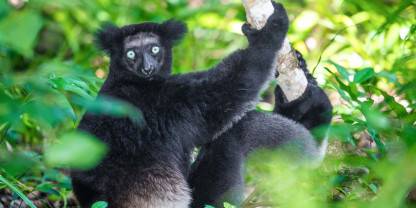Average Expert Rating
Rating Breakdown
Write a User ReviewLemurs Abound by the Beach
This tiny, 50-hectare private reserve is a great place to see literally tons of different lemurs. They’re everywhere. You’ll find them in the trees close to the lodge or while strolling along the reserve’s many forested hiking trails. You’ll also see them lounging on the roof of your beach-style cabanas, with some being cheeky enough to rush the open-air restaurant at meal times with the intention of pilfering food from your plate. During my stay, I lost several bananas and a handful of chips.
The reserve is home to red-ruffed, brown, red-bellied, crowned, bamboo, and black-and-white ruffed lemurs (the last look a little like arboreal border collies). There are also a few families of indri (an animal with an operatic singing voice). At night, you are likely to encounter woolly lemurs, as well as the super-cute (and ever so tiny) mouse lemur.
But the icing on the cake is the aye-aye; arguably Madagascar’s oddest of oddities. This strange creature has long,
Although free-ranging, all the animals in the reserve are fed and should not be considered ‘truly wild’. But if you’re cool with that, you’ll have a lovely stay here, and come home with some great photographs and memories.
The reserve is home to red-ruffed, brown, red-bellied, crowned, bamboo, and black-and-white ruffed lemurs (the last look a little like arboreal border collies). There are also a few families of indri (an animal with an operatic singing voice). At night, you are likely to encounter woolly lemurs, as well as the super-cute (and ever so tiny) mouse lemur.
But the icing on the cake is the aye-aye; arguably Madagascar’s oddest of oddities. This strange creature has long,
Read more
spindly fingers on its hands, which are used to extricate grubs from beneath the bark of dead trees. It has a big, bushy tail, buck teeth, boggle eyes, and an outrageously unkempt hairstyle that looks as if it has just poked those fingers into a light socket. They are almost impossible to encounter anywhere in Madagascar due to their elusive nature, but at Palmarium, there are several of these weird and wonderful animals kept on an island.Although free-ranging, all the animals in the reserve are fed and should not be considered ‘truly wild’. But if you’re cool with that, you’ll have a lovely stay here, and come home with some great photographs and memories.
Lemur Paradise on the Pangalanes
Although I’m usually a bit of a snob when it comes to the authenticity of wilderness places, I couldn’t help but be charmed by the lemur interactions that make Palmarium such a popular reserve on the Pangalanes Canal of the east coast of Madagascar. If you want to see and photograph lots of different lemurs at close range without the effort of long rainforest hikes, this is the place for you. Some of the introduced habituated lemurs you’re certain to see are the acrobatic black-and-white ruffed lemurs as well as black, crowned and red-bellied lemurs. Slightly less conspicuous but worth finding on a guided stroll around the 50ha/123ac grounds is the all-black morph of indri. However much I loved furry lemurs jumping on my shoulder and performing all kinds of tricks in the hope of getting a little treat, I’d come here to see the mysterious aye-aye, the largest nocturnal primate in the world. This is the most reliable place to see these fascinating long-fingered, large-eared lemurs

